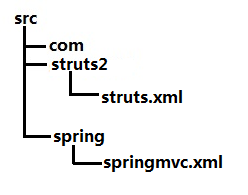修改Struts2的struts.xml配置文件位置
2014-05-21 20:13
363 查看
默认情况下,Struts2的配置文件名称为struts.xml,且该文件放在src根目录下。如下图所示:

如果需要修改struts.xml的位置,例如把struts.xml放到struts2文件夹下,结构如下图所示,该怎么办呢?

Struts2在web.xml中的一般配置如下:
[html]
view plaincopyprint?
<!-- 配置struts2过滤器:StrutsPrepareAndExecuteFilter -->
<filter>
<filter-name>struts2</filter-name>
<filter-class>org.apache.struts2.dispatcher.ng.filter.StrutsPrepareAndExecuteFilter</filter-class>
</filter>
<filter-mapping>
<filter-name>struts2</filter-name>
<url-pattern>/*</url-pattern>
</filter-mapping>
为了弄清Stuts2是如何加载配置文件的,先查看Struts2的StrutsPrepareAndExecuteFilter类:
[java]
view plaincopyprint?
package org.apache.struts2.dispatcher.ng.filter;
/**
* Handles both the preparation and execution phases of the Struts dispatching process. This filter is better to use
* when you don't have another filter that needs access to action context information, such as Sitemesh.
*/
public class StrutsPrepareAndExecuteFilter implements StrutsStatics, Filter {
protected PrepareOperations prepare;
protected ExecuteOperations execute;
protected List<Pattern> excludedPatterns = null;
public void init(FilterConfig filterConfig) throws ServletException {
InitOperations init = new InitOperations();
try {
FilterHostConfig config = new FilterHostConfig(filterConfig);
init.initLogging(config);
Dispatcher dispatcher = init.initDispatcher(config);
init.initStaticContentLoader(config, dispatcher);
prepare = new PrepareOperations(filterConfig.getServletContext(), dispatcher);
execute = new ExecuteOperations(filterConfig.getServletContext(), dispatcher);
this.excludedPatterns = init.buildExcludedPatternsList(dispatcher);
postInit(dispatcher, filterConfig);
} finally {
init.cleanup();
}
}
/**
* Callback for post initialization
*/
protected void postInit(Dispatcher dispatcher, FilterConfig filterConfig) {
}
public void doFilter(ServletRequest req, ServletResponse res, FilterChain chain) throws IOException, ServletException {
HttpServletRequest request = (HttpServletRequest) req;
HttpServletResponse response = (HttpServletResponse) res;
try {
prepare.setEncodingAndLocale(request, response);
prepare.createActionContext(request, response);
prepare.assignDispatcherToThread();
if ( excludedPatterns != null && prepare.isUrlExcluded(request, excludedPatterns)) {
chain.doFilter(request, response);
} else {
request = prepare.wrapRequest(request);
ActionMapping mapping = prepare.findActionMapping(request, response, true);
if (mapping == null) {
boolean handled = execute.executeStaticResourceRequest(request, response);
if (!handled) {
chain.doFilter(request, response);
}
} else {
execute.executeAction(request, response, mapping);
}
}
} finally {
prepare.cleanupRequest(request);
}
}
public void destroy() {
prepare.cleanupDispatcher();
}
}
可以看到,有个public void init(FilterConfig filterConfig) throws ServletException { ... } 方法,很明显,这个方法在启动时会被调用,然后加载classes目录下的struts.xml配置文件。配置文件参数名称为filterConfig。因此,我们可以指定Struts2 Filter 的参数,这和指定Servlet参数相同,配置<init-param>即可。配置如下:
[html]
view plaincopyprint?
<filter>
<filter-name>struts2</filter-name>
<filter-class>org.apache.struts2.dispatcher.ng.filter.StrutsPrepareAndExecuteFilter</filter-class>
<init-param>
<param-name>filterConfig</param-name>
<param-value>classpath:struts2/struts.xml</param-value>
</init-param>
</filter>
<filter-mapping>
<filter-name>struts2</filter-name>
<url-pattern>/*</url-pattern>
</filter-mapping>
这样配置后,就可以正常加载指定的Struts配置文件了。

如果需要修改struts.xml的位置,例如把struts.xml放到struts2文件夹下,结构如下图所示,该怎么办呢?

Struts2在web.xml中的一般配置如下:
[html]
view plaincopyprint?
<!-- 配置struts2过滤器:StrutsPrepareAndExecuteFilter -->
<filter>
<filter-name>struts2</filter-name>
<filter-class>org.apache.struts2.dispatcher.ng.filter.StrutsPrepareAndExecuteFilter</filter-class>
</filter>
<filter-mapping>
<filter-name>struts2</filter-name>
<url-pattern>/*</url-pattern>
</filter-mapping>
<!-- 配置struts2过滤器:StrutsPrepareAndExecuteFilter --> <filter> <filter-name>struts2</filter-name> <filter-class>org.apache.struts2.dispatcher.ng.filter.StrutsPrepareAndExecuteFilter</filter-class> </filter> <filter-mapping> <filter-name>struts2</filter-name> <url-pattern>/*</url-pattern> </filter-mapping>
为了弄清Stuts2是如何加载配置文件的,先查看Struts2的StrutsPrepareAndExecuteFilter类:
[java]
view plaincopyprint?
package org.apache.struts2.dispatcher.ng.filter;
/**
* Handles both the preparation and execution phases of the Struts dispatching process. This filter is better to use
* when you don't have another filter that needs access to action context information, such as Sitemesh.
*/
public class StrutsPrepareAndExecuteFilter implements StrutsStatics, Filter {
protected PrepareOperations prepare;
protected ExecuteOperations execute;
protected List<Pattern> excludedPatterns = null;
public void init(FilterConfig filterConfig) throws ServletException {
InitOperations init = new InitOperations();
try {
FilterHostConfig config = new FilterHostConfig(filterConfig);
init.initLogging(config);
Dispatcher dispatcher = init.initDispatcher(config);
init.initStaticContentLoader(config, dispatcher);
prepare = new PrepareOperations(filterConfig.getServletContext(), dispatcher);
execute = new ExecuteOperations(filterConfig.getServletContext(), dispatcher);
this.excludedPatterns = init.buildExcludedPatternsList(dispatcher);
postInit(dispatcher, filterConfig);
} finally {
init.cleanup();
}
}
/**
* Callback for post initialization
*/
protected void postInit(Dispatcher dispatcher, FilterConfig filterConfig) {
}
public void doFilter(ServletRequest req, ServletResponse res, FilterChain chain) throws IOException, ServletException {
HttpServletRequest request = (HttpServletRequest) req;
HttpServletResponse response = (HttpServletResponse) res;
try {
prepare.setEncodingAndLocale(request, response);
prepare.createActionContext(request, response);
prepare.assignDispatcherToThread();
if ( excludedPatterns != null && prepare.isUrlExcluded(request, excludedPatterns)) {
chain.doFilter(request, response);
} else {
request = prepare.wrapRequest(request);
ActionMapping mapping = prepare.findActionMapping(request, response, true);
if (mapping == null) {
boolean handled = execute.executeStaticResourceRequest(request, response);
if (!handled) {
chain.doFilter(request, response);
}
} else {
execute.executeAction(request, response, mapping);
}
}
} finally {
prepare.cleanupRequest(request);
}
}
public void destroy() {
prepare.cleanupDispatcher();
}
}
package org.apache.struts2.dispatcher.ng.filter;
/**
* Handles both the preparation and execution phases of the Struts dispatching process. This filter is better to use
* when you don't have another filter that needs access to action context information, such as Sitemesh.
*/
public class StrutsPrepareAndExecuteFilter implements StrutsStatics, Filter {
protected PrepareOperations prepare;
protected ExecuteOperations execute;
protected List<Pattern> excludedPatterns = null;
public void init(FilterConfig filterConfig) throws ServletException {
InitOperations init = new InitOperations();
try {
FilterHostConfig config = new FilterHostConfig(filterConfig);
init.initLogging(config);
Dispatcher dispatcher = init.initDispatcher(config);
init.initStaticContentLoader(config, dispatcher);
prepare = new PrepareOperations(filterConfig.getServletContext(), dispatcher);
execute = new ExecuteOperations(filterConfig.getServletContext(), dispatcher);
this.excludedPatterns = init.buildExcludedPatternsList(dispatcher);
postInit(dispatcher, filterConfig);
} finally {
init.cleanup();
}
}
/**
* Callback for post initialization
*/
protected void postInit(Dispatcher dispatcher, FilterConfig filterConfig) {
}
public void doFilter(ServletRequest req, ServletResponse res, FilterChain chain) throws IOException, ServletException {
HttpServletRequest request = (HttpServletRequest) req;
HttpServletResponse response = (HttpServletResponse) res;
try {
prepare.setEncodingAndLocale(request, response);
prepare.createActionContext(request, response);
prepare.assignDispatcherToThread();
if ( excludedPatterns != null && prepare.isUrlExcluded(request, excludedPatterns)) {
chain.doFilter(request, response);
} else {
request = prepare.wrapRequest(request);
ActionMapping mapping = prepare.findActionMapping(request, response, true);
if (mapping == null) {
boolean handled = execute.executeStaticResourceRequest(request, response);
if (!handled) {
chain.doFilter(request, response);
}
} else {
execute.executeAction(request, response, mapping);
}
}
} finally {
prepare.cleanupRequest(request);
}
}
public void destroy() {
prepare.cleanupDispatcher();
}
}可以看到,有个public void init(FilterConfig filterConfig) throws ServletException { ... } 方法,很明显,这个方法在启动时会被调用,然后加载classes目录下的struts.xml配置文件。配置文件参数名称为filterConfig。因此,我们可以指定Struts2 Filter 的参数,这和指定Servlet参数相同,配置<init-param>即可。配置如下:
[html]
view plaincopyprint?
<filter>
<filter-name>struts2</filter-name>
<filter-class>org.apache.struts2.dispatcher.ng.filter.StrutsPrepareAndExecuteFilter</filter-class>
<init-param>
<param-name>filterConfig</param-name>
<param-value>classpath:struts2/struts.xml</param-value>
</init-param>
</filter>
<filter-mapping>
<filter-name>struts2</filter-name>
<url-pattern>/*</url-pattern>
</filter-mapping>
<filter> <filter-name>struts2</filter-name> <filter-class>org.apache.struts2.dispatcher.ng.filter.StrutsPrepareAndExecuteFilter</filter-class> <init-param> <param-name>filterConfig</param-name> <param-value>classpath:struts2/struts.xml</param-value> </init-param> </filter> <filter-mapping> <filter-name>struts2</filter-name> <url-pattern>/*</url-pattern> </filter-mapping>
这样配置后,就可以正常加载指定的Struts配置文件了。
相关文章推荐
- 修改Struts2的struts.xml配置文件位置
- 修改Struts2的struts.xml配置文件位置
- 修改Struts2的struts.xml配置文件位置
- 修改Struts2的struts.xml配置文件位置
- 修改Struts2的struts.xml配置文件位置和名称-重点是init-param参数用来切换加载的路径
- 修改Struts2的struts.xml配置文件位置
- 修改Struts2的struts.xml配置文件位置
- 修改Struts2的struts.xml配置文件位置
- struts2:struts.xml配置文件详解
- struts2的struts.xml struts.properties配置文件
- struts2 配置文件 struts.xml
- struts2 struts.xml配置文件详解
- Struts2的配置文件——struts.xml
- 修改Struts2.xml配置文件在工程中的位置
- struts2配置文件(摘录) struts2.0中struts.xml配置文件详解
- 【学习笔记】Struts2之配置文件struts.xml
- Struts2 -----struts.xml配置文件(RedirectAction方式)
- struts2 struts.xml配置文件详解
- struts2 修改配置文件的默认位置报异常的解决方法
- struts2 中 struts.xml文件属性配置
